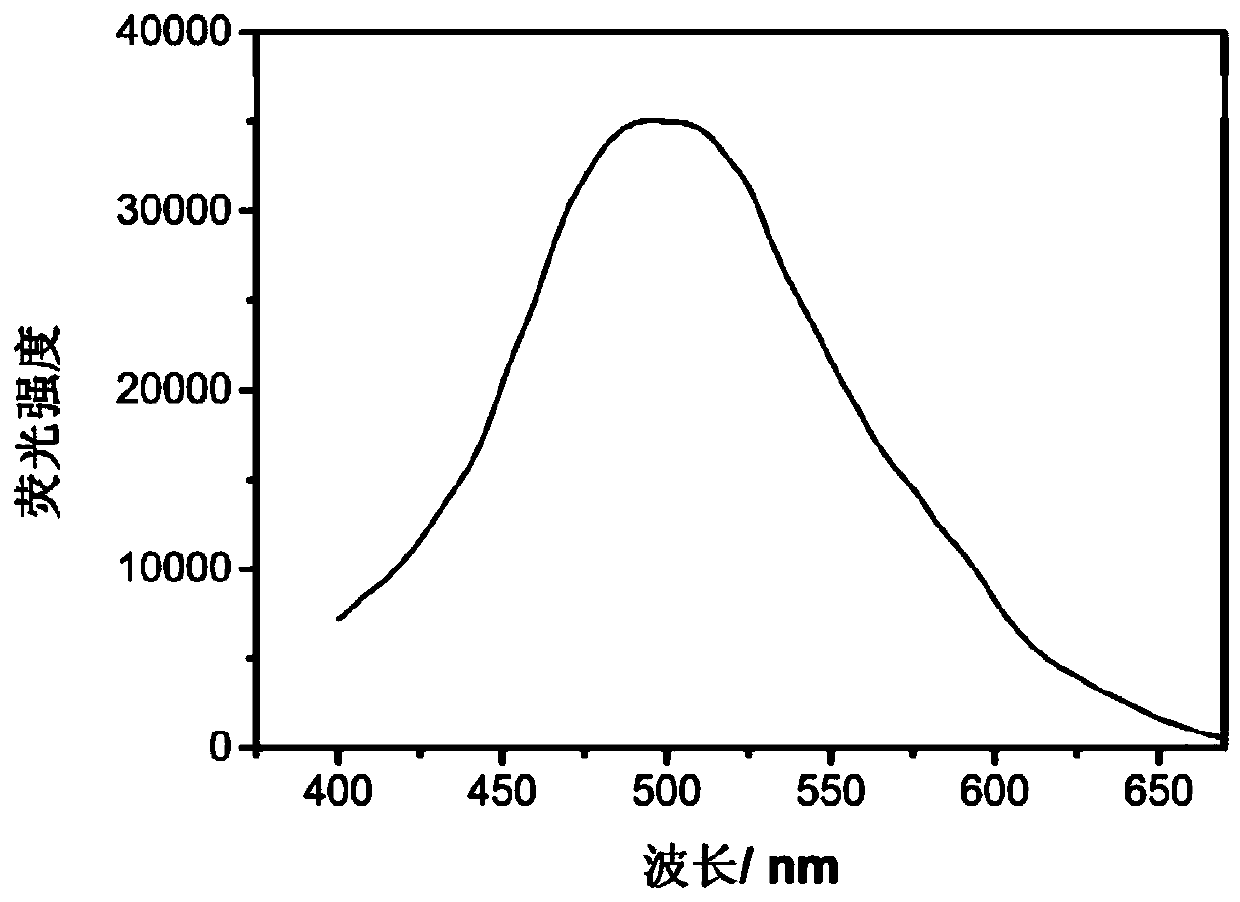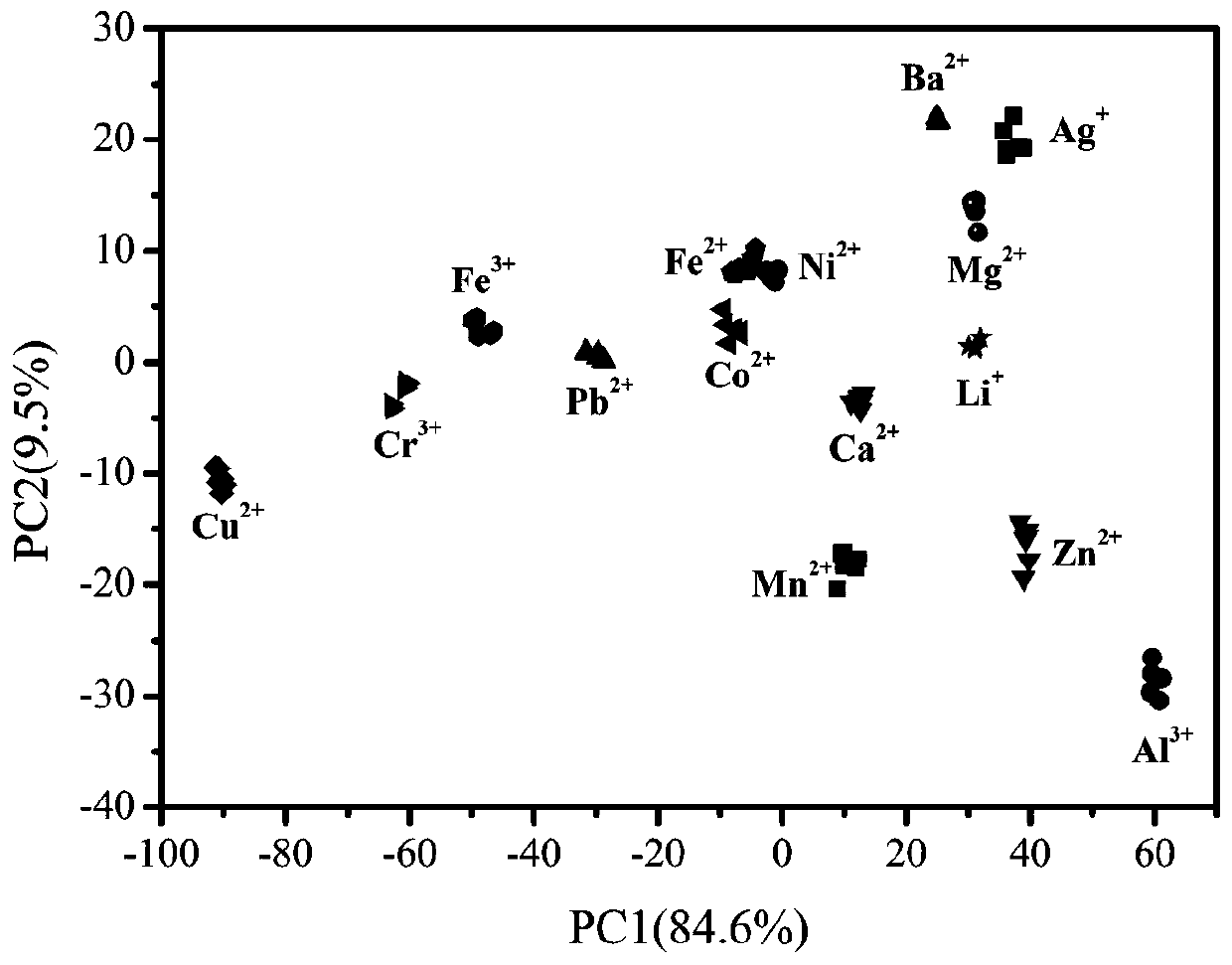Metal ion detection method based on graphene quantum dot fluorescent probe array
A technology of graphene quantum dots and metal ions, applied in the field of nanoscience, can solve problems such as kidney damage, nervous system, and digestive system heart disease, and achieve the effects of strong controllability, intuitive result judgment, and simple preparation methods
- Summary
- Abstract
- Description
- Claims
- Application Information
AI Technical Summary
Problems solved by technology
Method used
Image
Examples
specific Embodiment 1
[0029] Graphene quantum dot fluorescent probe arrays to detect metal ions include the following steps:
[0030] (1) Preparation of graphene quantum dots: 30 mg of graphene oxide powder was added to 30 mL of secondary water, placed in an ultrasonic cleaner for ultrasonic dispersion, and then 1 mL of hydrogen peroxide was added for uniform ultrasonic dispersion. The mixed solution was transferred to the reaction kettle, sealed and reacted at 180°C for 90 minutes. The reaction solution was filtered through a 0.22 μm water-based filter membrane, and the filtrate was collected to obtain an aqueous dispersion of graphene quantum dots, which was freeze-dried. The results show that the synthesized graphene quantum dots are uniform in size, with an average particle size of 3.7nm ( figure 1 a), when excited with 360nm light, it can emit fluorescence with a maximum emission wavelength of 496nm ( figure 2 ).
[0031] (2) Preparation of nitrogen-doped graphene quantum dots: 50 mg of graphene ...
specific Embodiment 2
[0036] Graphene quantum dot fluorescent probe arrays to detect metal ions include the following steps:
[0037] (1) Preparation of graphene quantum dots: 30 mg of graphene oxide powder was added to 30 mL of secondary water, placed in an ultrasonic cleaner for ultrasonic dispersion, and then 1 mL of hydrogen peroxide was added for uniform ultrasonic dispersion. The mixed solution was transferred to the reaction kettle, sealed and reacted at 180°C for 90 minutes. The reaction solution was suction filtered through a 0.22 μm aqueous filter membrane, and the filtrate was collected to obtain an aqueous dispersion of graphene quantum dots, which was freeze-dried. The results show that the synthesized graphene quantum dots are uniform in size, with an average particle size of 3.7 nm.
[0038] (2) Preparation of nitrogen-doped graphene quantum dots: 50 mg of graphene quantum dots were added to 100 mL of secondary water, and placed in an ultrasonic cleaner for ultrasonic dispersion for 15 m...
specific Embodiment 3
[0043] Graphene quantum dot fluorescent probe arrays to detect metal ions include the following steps:
[0044] (1) Preparation of graphene quantum dots: 30 mg of graphene oxide powder was added to 30 mL of secondary water, placed in an ultrasonic cleaner for ultrasonic dispersion, and then 1 mL of hydrogen peroxide was added for uniform ultrasonic dispersion. The mixed solution was transferred to the reaction kettle, sealed and reacted at 180°C for 90 min. The reaction solution was suction filtered through a 0.22 μm aqueous filter membrane, and the filtrate was collected to obtain an aqueous dispersion of graphene quantum dots, which was freeze-dried. The results show that the synthesized graphene quantum dots are uniform in size, with an average particle size of 3.7 nm.
[0045] (2) Preparation of nitrogen-doped graphene quantum dots: 50 mg of graphene quantum dots were added to 100 mL of secondary water, and placed in an ultrasonic cleaner for ultrasonic dispersion for 15 minut...
PUM
| Property | Measurement | Unit |
|---|---|---|
| particle size | aaaaa | aaaaa |
| particle size | aaaaa | aaaaa |
| particle size | aaaaa | aaaaa |
Abstract
Description
Claims
Application Information
 Login to View More
Login to View More - R&D
- Intellectual Property
- Life Sciences
- Materials
- Tech Scout
- Unparalleled Data Quality
- Higher Quality Content
- 60% Fewer Hallucinations
Browse by: Latest US Patents, China's latest patents, Technical Efficacy Thesaurus, Application Domain, Technology Topic, Popular Technical Reports.
© 2025 PatSnap. All rights reserved.Legal|Privacy policy|Modern Slavery Act Transparency Statement|Sitemap|About US| Contact US: help@patsnap.com



